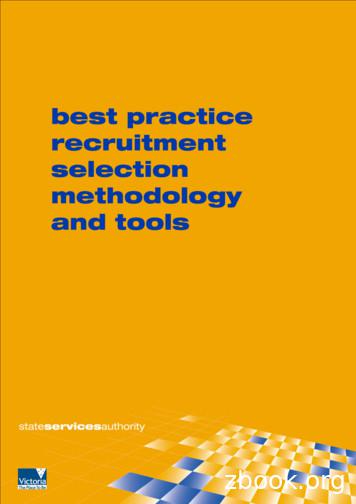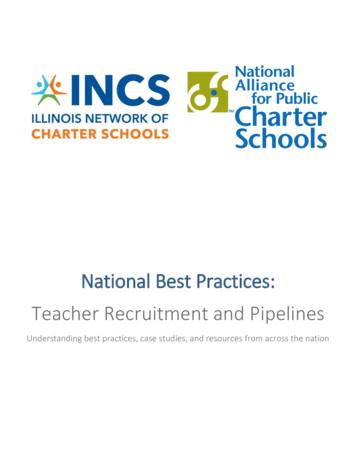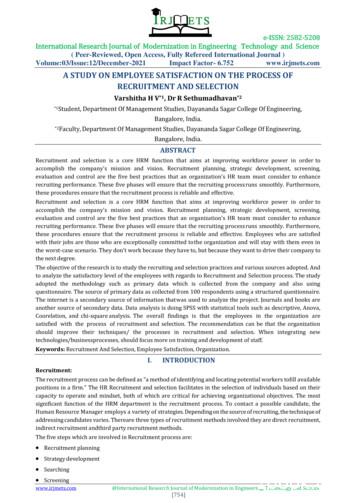Recruitment & Selection Best Practice Guide
Recruitment & SelectionBest Practice GuideJune 2017
ContentsIntroduction . 5Recruitment, Selection and Appointment Policy. 5Role of the Human Resources Team . 5eRecruit (via MyHROnline). 5Part 1 – Defining the Position (Pre‐Recruitment) . 6Job Analysis .6Position Description / Duty Descriptor . 6Position Evaluation . 7Approval to Create / Change the Position. 7Forms. 7Part 2 – Approval to Recruit . 8Appointment types . 8Redeployment . 8Continuing Appointments. 8Fixed Term Appointments . 8Secondments . 9Internal Secondments . 9External Secondments (Secondments to/from outside organisations). 9Direct Appointments. 10Acting Higher Grade. 10Head of College/Director Appointments . 10Associate Dean Appointments – Teaching and Learning, Research and Research Training . 10Adjunct Appointments (non JCU Employees). 10Forms. 11Part 3 – Planning to Recruit. 11Conducting a "Job Brief" with your HR/Recruitment Professional . 11The Selection Committee. 11Role of the Selection Committee Chairperson . 11Role of the Selection Committee . 11Composition of the Selection Committee . 13Inclusion of an External Selection Committee Member . 142
Confidentiality . 15Conflict of Interest . 15How do I use prior knowledge of the applicant, whilst acting as a Selection Committee Chair or member? . 15Selection Committee Training . 15International Recruitment. 15Part 4 – Attracting Applicants . 16Advertising and Sourcing . 16Placing advertisements . 16Sourcing / Advertising Mediums . 16Print Media . 17On‐line Media . 17Other Media . 17Professional Networks . 17Recruitment Agent. 17Addressing Selection Criteria (where required) . 17Part 5 – Selecting the Applicant . 18Factors to consider when assessing Selection Techniques . 18Common Selection Techniques. 19Shortlisting . 19Interview . 19Reference Checking . 20Conducting the Reference Check . 20Confidentiality of Reference Checks. 20Inconsistent Reference Checks. 20Can a Selection Committee member also act as a Referee? . 21Other Selection Techniques . 21Work Samples. 21Video Interviewing . 21Presentations. 21Psychometric Testing . 21Assessment Centre . 21Job Knowledge Tests . 22Competency Test . 222
Situational Judgment Tests (Scenario based tests). 22Practical / Skill Assessments . 22Physical Fitness/Ability Test . 22Background Checks. 22Forms. 23Part 6 – Appointing the Applicant . 23Making an offer of appointment. 23Authority to make an offer of employment . 23Verifying Qualifications and other credentials . 23Order of Merit . 24Eligibility List . 24Remuneration . 24Negotiating the Offer. 24Relocations Policy . 24Formalising the Offer (Contract of employment) . 25Notifying Unsuccessful Applicants . 25Providing Feedback to Unsuccessful Applicants . 25FORMS. 26Part 7 – The Next Steps . 26Recruitment and Selection Documentation . 26Onboarding, including Induction . 27Probation . 27Complaints against the Recruitment & Selection Process . 27FORMS . 27Appendix A –Recruitment & Selection Workflow . 28Acknowledgements . 29Approval Details . 29Modification History Details . 292
IntroductionThe purpose of this guide is to provide managers and selection committees with information regarding recruitmentand selection at James Cook University. This guide ensures core activities of recruitment and selection areundertaken in‐line with relevant JCU Policy. In addition it emphasizes the need for different approaches andactivities that can be taken to ensure appropriate sized pools of applicants are attracted to the University and therole, and that appropriate selection techniques are undertaken to ensure the person selected for appointment isthe most suitable to the role and environment.Each recruitment and selection activity reflects on the employment brand of the University.This document must be read in conjunction with the Recruitment, Selection and Appointment Policy.Recruitment, Selection and Appointment PolicyThe Recruitment and Selection Policy captures the overarching and fundamental principles of recruitment andselection at James Cook University; these are to be complied with irrespective of the particular recruitment andselection activity being undertaken.Role of the Human Resources TeamThe Human Resources Team can offer advice on Recruitment and Selection.Your local Human Resources Consultant or Recruitment Officer can assist with job analysis, recruitment planning(conducting the job brief), including identifying appropriate advertising mediums, avenues to source applicants andappropriate selection methodologies.eRecruit (via MyHROnline)James Cook University uses an electronic recruiting process known as eRecruit, which is accessed through My HROnline. eRecruit is a tool to support the recruitment and selection activity. After approval is received to advertise arole, the advertisement is entered into eRecruit, allowing for immediate advertising to Jobs@JCU. eRecruit allowsthe Selection Committee Chairs and Committee Members to have easy and immediate access to all applicants.With an online shortlisting function, this streamlines the process of identifying appropriate candidates, helping toimprove the quality and quantity of the applicant pool and reduce costs of recruitment.Please refer to the eRecruit manual or your Human Resources Consultant for more information about the eRecruitprocess.4
Part 1 – Defining the Position (Pre‐Recruitment)For a recruitment and selection activity to commence the role must be clearly defined and understood, as well asexist in the University's approved staff budget and therefore in JCU’s Human Resources Management InformationSystem (HRMIS), ALESCO.Job AnalysisBefore commencing a recruitment activity, it is important to examine the requirements of the role, in its own rightand if applicable, in relation to other roles in the team. The Job Analysis will look to accurately reflect therequirements of the role and any changes required to the role in relation to other roles across the team and in linewith strategic business direction.The result of an effective Job Analysis process enables the creation of a Position Description / Duty Descriptor forthe role, ensuring the value of the role is evaluated fairly, and the position is clearly defined to ensure anappropriate match of the person to the role requirements.Your HR Consultant can access tools and advise on an approach to conduct a Job Analysis.Position Description / Duty DescriptorThe Position Description (for HEWL classified roles and Research HEWL equivalent roles) provides applicants with aclear understanding of the role; purpose, accountabilities and responsibilities, along with the requirements,knowledge, skills and abilities to be successful in the role. It relates to the classification descriptors contained in theEnterprise Agreement. Once employed, the position description is the basis for performance on the job.The Duty Descriptor (for Academic classified roles and Research Academic equivalent roles) provides applicantswith an outline of the role, its accountabilities and responsibilities and relates to the classification descriptorscontained in the Enterprise Agreement. Once employed, the Duty Descriptor provides an overview of the focus ofthe role.Selection CriteriaAn important part of a Position Description is the Selection Criteria. The Selection Criteria are essential anddesirable criteria required of someone within the position that will enable them to more fully perform at requiredlevels and achieve desired accountabilities. These criteria may include qualifications, experience, knowledge, skills,abilities or aptitudes. All Selection Criteria must be job related.Selection Criteria form the basis of all recruitment activities within James Cook University and will drive the typesof selection techniques used within the recruitment process. It is therefore vital to ensure full consideration isgiven within the creation of the Position Description of the purpose, accountabilities and subsequently whatcriteria is required to select the best candidate. Doing this allows the greatest success of recruiting the mostsuitable candidate who will achieve the purpose and outc
The purpose of this guide is to provide managers and selection committees with information regarding recruitment and selection at James Cook University. This guide ensures core activities of recruitment and selection are undertaken in‐line with relevant JCU Policy. In addition it emphasizes the need for different approaches and
2.1 best practice recruitment selection process A clearly defined methodology for recruitment selection processes helps ensure that all necessary elements are given due consideration and occur in a timely and efficient manner to support an effective yet swift selection process. Figure 1 provides an end-to-end best practice recruitment
recruitment as early as possible, treating recruitment as a year -round focus, and engaging as many staff members as possible in the process. CALENDAR BEST PRACTICES DESCRIPTION RESOURCES Inclusion of all events that impact recruitment Selection Guide Should outline recruitment goals. Should be holistic and include all recruitment
This Recruitment and Selection Guide describes best practice principles that will give managers and recruiters the knowledge to conduct ‘fit for purpose’ recruitment and selection processes to assist in the attraction, selection and retention of the best candidates possible. 2. Merit, Diversity and Ethics Merit principles
HR Recruitment Tools - Testing and assessment tools - 57 % of the companies use preliminary assessment tools to assess the skills and knowledge of the applicants. Technical assessment is a common practice in the recruitment process of software developers; - Recruitment CRMs - Recruitment CRMs gain popularity with the rise of recruitment
Recruitment Counselor Guide Recruitment Counselor Implementation Timeline, 8 Recruitment Counselor Implementation Timeline The most successful recruitments are planned far in advance, and the recruitment counselor program is a big aspect of the overall recruitment preparation. Every campus is unique, but the following timeline should help give the
1.3.2 The purpose of this Toolkit is to assist with the following areas of recruitment and selection: (a) Principles underlying recruitment and selection practices There are a number of principles that have to be taken into consideration, not only in the day to day management of recruitment and selection,but also in terms of policy development.
recruitment are very effective. The main source of internal recruitment is employee referral as rewards are provided to employee to encourage this kind of recruitment. Thiruvenkatraj T R, Nirmal Kumar R (2018) in the research paper titled "A study on recruitment and selection process" is examined and the objective is study process. 3
Accounting information and managerial work. Accounting, Organizations and Society, 35 (3), 301-315. ABSTRACT . Despite calls to link management accounting more closely to management (Jonsson, 1998), much is still to be learned about the role of accounting information in managerial work. This lack of progress stems partly from a failure to incorporate in research efforts the findings regarding .























